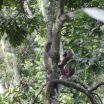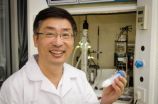(Press-News.org) Supernovae are amongst the most violent events in nature. They mark the dazzling deaths of stars and can outshine the combined light of the billions of stars in their host galaxies.
In 1999 the Lick Observatory in California reported the discovery of a new supernova in the spiral galaxy NGC 1637. It was spotted using a telescope that had been specially built to search for these rare, but important cosmic objects [1]. Follow-up observations were requested so that the discovery could be confirmed and studied further. This supernova was widely observed and was given the name SN 1999em. After its spectacular explosion in 1999, the supernova's brightness has been tracked carefully by scientists, showing its relatively gentle fading through the years.
The star that became SN 1999em was very massive -- more than eight times the mass of the Sun -- before its death. At the end of its life its core collapsed, which then created a cataclysmic explosion [2].
When they were making follow up observations of SN 1999em astronomers took many pictures of this object with the VLT, which were combined to provide us with this very clear image of its host galaxy, NGC 1637. The spiral structure shows up in this image as a very distinct pattern of bluish trails of young stars, glowing gas clouds and obscuring dust lanes.
Although at first glance NGC 1637 appears to be a fairly symmetrical object it has some interesting features. It is what astronomers classify as a lopsided spiral galaxy: the relatively loosely wound spiral arm at the top left of the nucleus stretches around it much further than the more compact and shorter arm at the bottom right, which appears dramatically slashed midway through its course.
Elsewhere in the image the view is scattered with much closer stars and more distant galaxies that happen to lie in the same direction.
INFORMATION:
Notes
[1] The supernova was discovered by the Katzman Automatic Imaging Telescope (http://astro.berkeley.edu/bait/public_html/kait.html), at Lick Observatory on Mount Hamilton, California.
[2] SN 1999em is a core-collapse supernova classified more precisely as a Type IIp. The "p" stands for plateau, meaning supernovae of this type remain bright (on a plateau) for a relatively long period of time after maximum brightness.
More information
ESO is the foremost intergovernmental astronomy organisation in Europe and the world's most productive ground-based astronomical observatory by far. It is supported by 15 countries: Austria, Belgium, Brazil, the Czech Republic, Denmark, France, Finland, Germany, Italy, the Netherlands, Portugal, Spain, Sweden, Switzerland and the United Kingdom. ESO carries out an ambitious programme focused on the design, construction and operation of powerful ground-based observing facilities enabling astronomers to make important scientific discoveries. ESO also plays a leading role in promoting and organising cooperation in astronomical research. ESO operates three unique world-class observing sites in Chile: La Silla, Paranal and Chajnantor. At Paranal, ESO operates the Very Large Telescope, the world's most advanced visible-light astronomical observatory and two survey telescopes. VISTA works in the infrared and is the world's largest survey telescope and the VLT Survey Telescope is the largest telescope designed to exclusively survey the skies in visible light. ESO is the European partner of a revolutionary astronomical telescope ALMA, the largest astronomical project in existence. ESO is currently planning the 39-metre European Extremely Large optical/near-infrared Telescope, the E-ELT, which will become "the world's biggest eye on the sky".
Links
FORS instrument: http://www.eso.org/sci/facilities/paranal/instruments/fors/
Photos of the VLT: http://www.eso.org/public/images/archive/category/paranal/
Contacts
Richard Hook
ESO, La Silla, Paranal, E-ELT & Survey Telescopes Press Officer
Garching bei München, Germany
Cell: 49-151-1537-3591
Spiral beauty graced by fading supernova
2013-03-20
ELSE PRESS RELEASES FROM THIS DATE:
Estrogen helps keep joint pain at bay after hysterectomy
2013-03-20
CLEVELAND, Ohio (March 20, 2013)—Estrogen therapy can help keep joint pain at bay after menopause for women who have had a hysterectomy. Joint pain was modestly, but significantly, lower in women who took estrogen alone than in women who took placebo in the Women's Health Initiative (WHI) trial. The findings were published online today in Menopause, the journal of The North American Menopause Society.
Studies looking at how estrogen affects joint pain in women after menopause have had mixed results. But this analysis of data on some 1,000 women who had hysterectomies—representative ...
Estrogen may relieve post-menopausal joint pain
2013-03-20
Post-menopausal women, who often suffer from joint pain, could find some long-term relief by taking estrogen-only medication, according to a new study based on the Women's Health Initiative (WHI) that was released online today by the journal, Menopause.
Previous studies of estrogen's influence on joint symptoms had produced mixed results, so researchers examined the findings of the WHI, the largest-ever study of the use of hormonal therapy in post-menopausal women. They examined the findings of the women enrolled in the Estrogen-Alone program, in which women who had undergone ...
Discovery of first motor with revolution motion in a virus-killing bacteria advances nanotechnology
2013-03-20
Scientists have cracked a 35-year-old mystery about the workings of the natural motors that are serving as models for development of a futuristic genre of synthetic nanomotors that pump therapeutic DNA, RNA or drugs into individual diseased cells. Their report revealing the innermost mechanisms of these nanomotors in a bacteria-killing virus — and a new way to move DNA through cells — is being published online today in the journal ACS Nano.
Peixuan Guo and colleagues explain that two motors have been found in nature: A linear motor and a rotating motor. Now they report ...
A milestone for new carbon-dioxide capture/clean coal technology
2013-03-20
An innovative new process that releases the energy in coal without burning — while capturing carbon dioxide, the major greenhouse gas — has passed a milestone on the route to possible commercial use, scientists are reporting. Their study in the ACS journal Energy & Fuels describes results of a successful 200-hour test on a sub-pilot scale version of the technology using two inexpensive but highly polluting forms of coal.
Liang-Shih Fan and colleagues explain that carbon capture and sequestration ranks high among the approaches for reducing coal-related emissions of the ...
Explaining how extra virgin olive oil protects against Alzheimer's disease
2013-03-20
The mystery of exactly how consumption of extra virgin olive oil helps reduce the risk of Alzheimer's disease (AD) may lie in one component of olive oil that helps shuttle the abnormal AD proteins out of the brain, scientists are reporting in a new study. It appears in the journal ACS Chemical Neuroscience.
Amal Kaddoumi and colleagues note that AD affects about 30 million people worldwide, but the prevalence is lower in Mediterranean countries. Scientists once attributed it to the high concentration of healthful monounsaturated fats in olive oil — consumed in large amounts ...
Scientists discover reasons behind snakes' 'shrinking heads'
2013-03-20
An international team of scientists led by Dr Kate Sanders from the University of Adelaide, and including Dr Mike Lee from the South Australian Museum, has uncovered how some sea snakes have developed 'shrunken heads' – or smaller physical features than their related species.
Their research is published today in the journal Molecular Ecology (doi: 10.1111/mec.12291).
A large head – "all the better to eat you with" - would seem to be indispensable to sea snakes, which typically have to swallow large spiny fish. However, there are some circumstances where it wouldn't ...
Hunting for meat impacts on rainforest
2013-03-20
Hunting for meat in the African rainforests has halved the number of primates. However, the hunting also has other negative consequences. The decline in the number of primates causes a reduction in the dispersal of seed by the primates, and this leads to a reduction in the numbers of important fruit trees and changes to the rainforest. This has been shown in new research from Lund University in Sweden.
The destruction of the world's rainforests is generally recognised as a major problem. However, it is not only felling and clear-cutting that change the rainforest. A research ...
NTU scientist develops a multi-purpose wonder material to tackle enviromental challenges
2013-03-20
A new wonder material that can generate hydrogen, produce clean water and even create energy.
Science fiction? Hardly, and there's more - It can also desalinate water, be used as flexible water filtration membranes, help recover energy from desalination waste brine, be made into flexible solar cells and can also double the lifespan of lithium ion batteries. With its superior bacteria-killing capabilities, it can also be used to develop a new type of antibacterial bandage.
Scientists at Nanyang Technological University (NTU) in Singapore, led by Associate Professor Darren ...
Thin films of nickel and iron oxides yield efficient solar water-splitting catalyst
2013-03-20
EUGENE, Ore. -- (March 20, 2013) -- University of Oregon chemists say that ultra-thin films of nickel and iron oxides made through a solution synthesis process are promising catalysts to combine with semiconductors to make devices that capture sunlight and convert water into hydrogen and oxygen gases.
Researchers in the Solar Materials and Electrochemistry Laboratory of Shannon Boettcher, professor of chemistry, studied the catalyst material and also developed a computer model for applying catalyst thin films in solar water-splitting devices as a tool to predict the effectiveness ...
New study highlights strong anti-cancer properties of soybeans
2013-03-20
Soybean meal is a bi-product following oil extraction from soybean seeds. It is rich in protein, which usually makes up around 40% of the nutritional components of the seeds and dependent on the line, and can also contain high oleic acid (a monounsaturated omega-9 fatty acid).
The study looked at the role soybeans could have in the prevention of cancer. Using a variety of soybean lines which were high in oleic acid and protein, the researchers looked to monitor bioactivity between the peptides derived from the meals of soybean and various types of human cancer cells. ...


